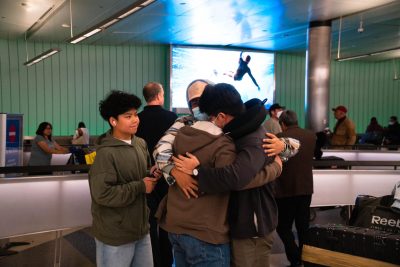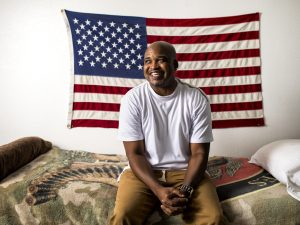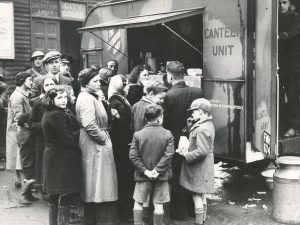Thirteen anti-trafficking programs served 443 survivors.
The Salvation Army across the Western U.S. received a 385 percent increase in human trafficking referrals in 2022.
Referrals jumped to 1,020 instances from 210 the year prior, according to the Army’s annual impact report summarizing efforts to help trafficking survivors. The higher number suggests increased awareness of the problem and a growing recognition that The Salvation Army has resources to help, according to Jacqui Larsson, Social Justice Ministries Director for the Western Territory.
Across the Western U.S., 13 anti-trafficking programs offer drop-in centers and residential programs. Larsson said individuals needing help are usually referred to The Salvation Army through task force networks, including healthcare workers, police officers and teachers.
“The main point is that they can look out for the red flags, the clues that would show who the most vulnerable are—the girls, boys, women and men who are in danger,” she said, noting the many training sessions held throughout 2022 with the organization’s social service staff. “And then know how to respond.”
The focus on training may account for some other numbers on the 2022 report: nights of lodging provided jumped 575 percent (from 4,569 to 30,819 nights), as did the case management hours, which rose to 6,693 from the previous year’s 2,890 hours.
Human trafficking too continues to grow, despite increased awareness. While compiling accurate trafficking data is difficult, Statista reported the number of identified victims worldwide quadrupled between 2008 to 2019, from an estimated 30,000 to 120,000 people.
– Referrals jumped to 1,020 instances from 210 in 2021.
– Nights of lodging provided jumped 575 percent, from 4,569 to 30,819 nights.
– Case management hours increased, rising to 6,693 from the previous year’s 2,890 hours.
The Salvation Army has 13 anti-trafficking programs across the Western U.S., offering drop-in centers and residential programs.
Internationally, The Salvation Army is committed to doing its part in the fight against trafficking through both awareness training and services for survivors. In the United States, this initiative includes Fight for Freedom, a 10-year action plan launched in 2016 to combat trafficking.
Larsson said traffickers are smart and their targeting requires those assisting victims to be vigilant and often adapt how services are provided. For example, some will take advantage of outreach events to people in need, including food distributions, Larsson said, to target potential victims.
“The traffickers focus on the vulnerable in society. They trick them into believing that they can fill the voids and give them what they need by telling the vulnerable people that they love them, that they will take care of them, buy them meals and nice clothes, or provide a place to stay—and then they have control and exploit those in need,” she said, noting the importance for Salvation Army staff and volunteers to be trained in how to react to a potential trafficking situation.
“You have to respond carefully,” she said, adding that victims often don’t realize they’re being trafficked. When suspicious, she said staff might strike up a conversation with the individual, distracting them away from potential harm.
The Salvation Army also posts awareness decals in its social service facilities with questions that suggest trafficking without specifically asking, “Are you being trafficked?” Larsson said these materials instead might ask: Are you not allowed to leave your job? Are you not in control of the money you earn? Are you threatened if you don’t follow the rules? Are you forced to provide work or services against your will?
Building awareness
The Social Justice Ministries Department hosted 91 awareness, prevention and outreach events, reaching 5,960 people, in 2022. More than 900 people received in-depth training, up from 261 in 2021, something Orange County Anti-Trafficking Services (ATS) Manager Morgan Guzman applauded.
According to a 2022 report from New University, some 80 percent of human trafficking victims from around the country end up in Orange County, California.
Guzman said the Army’s Orange County program helps survivors of both labor and sex trafficking, including a 24-hour-staffed safe home for American-born, sex-trafficked females between the ages of 18 to 25 and three guest houses for foreign nationals, including male and female survivors of labor trafficking.
In February, Guzman celebrated with Joel, a graduate of Orange County’s ATS program, at Los Angeles International Airport as he reunited with his two sons from the Philippines. They had not seen each other face-to-face in 16 years.
Guzman said Joel came to the program a couple of years ago with a group of six men who were being trafficked.

“Referrals come from all over the place. Sometimes they come from current clients, who have friends who need help,” she said. “We wouldn’t be able to do any of this without our partner agencies. It definitely takes a whole community task force to try to combat this because it’s growing; it’s not going away. No agency can do it by themselves.”
The Salvation Army partners with Public Law Center (PLC), which helps immigrants with housing and legal issues, Homeland Security Waymakers, the Orange County Human Trafficking Task Force and the National Human Trafficking hotline.
Guzman said she has to be ready every day for the unexpected.
“It’s definitely a lot to respond to,” she said. “And there’s the regular things that need to get done throughout the day—making sure the house is kept up, that the vehicles have gasoline, making sure clients get to work or to school or to their therapy, and making sure the chore chart and shift logs are completed.”
And still, the work has its rewards.
“It’s the survivors and seeing the resilience they have—it motivates me to keep going and to keep helping. It’s an honor to be able to walk alongside them,” she said. “Just seeing that they get up every day and they’re trying to get back on their feet is very motivating for me to get up and get on my feet and continue to do the work.”
Looking ahead, Larsson said she hopes to see The Salvation Army connected to more task forces like the one in Orange County.
“One of the things we highlight is the need for collaboration,” she said. “With this kind of work, the importance of joining with other organizations in our communities is huge.”
Do Good:
- Did you know The Salvation Army served 31 million Americans last year fighting hunger, homelessness, substance abuse and more—all in a Fight for Good? Where can you help? Take our quiz to find your cause and learn how you can join in today.
- Want more content from Caring Magazine? Follow us on Instagram! Get caught up with the latest stories, podcasts and more to inspire goodness in your life.
- Discover more about how The Salvation Army fights human trafficking.












